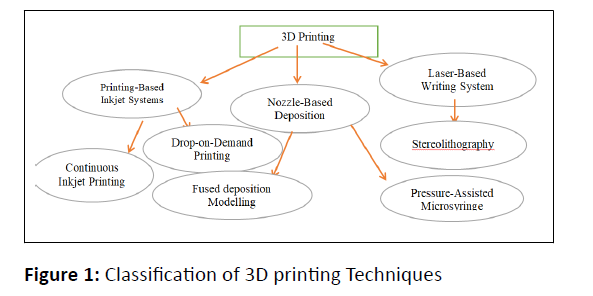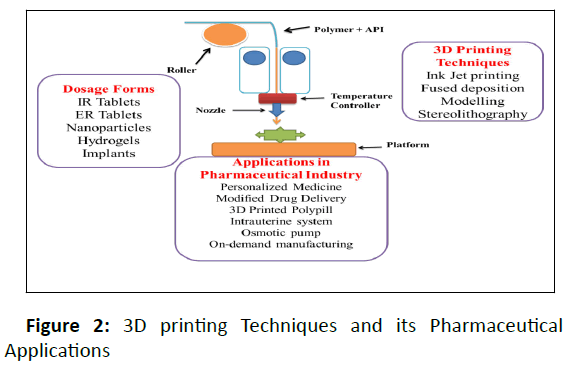ISSN : 2347-5447
British Biomedical Bulletin
Application of 3d Printing in Pharmaceutical Industry
Surabhi Jain1, Nadim MR Chhipa2, Dhrubo Jyoti Sen3* and Dhanajoy Saha4
1Faculty of Pharmacy, B. Pharmacy College Rampura-kakanpur, (Gujarat Technological University), Panchmahals, Gujarat, India
2Arihant School of Pharmacy & Bio Research Institute, Uvarsad Square, Sarkhej-Gandhinagar Highway, Post Adalaj, Gandhinagar, Gujarat, India
3School of Pharmacy, Techno India University, Salt Lake Campus, Kolkata-West Bengal, India
4Directorate of Technical Education, Bikash Bhavan, Salt Lake City, Kolkata, West Bengal, India
- *Corresponding Author:
- hrubo Jyoti Sen
School of Pharmac,Technology India Uneirvsity,
SaltLaek City, West Benagl,
India.
Email: dhrubojyoti.s@technoindiaeducation.com
Received date:August 06, 2022, Manuscript No. IPBBB-22-9953; Editor assigned date:July 08, 2022, PreQC No.IPBBB-22-9953 (PQ);Reviewed date: July 18, 2022, QC No IPBBB-22-9953; Revised date: July 27, 2022, Manuscript No. IPBBB-22-9953 (R); Published date: August 05, 2022, DOI: 10.36648/2347-5447.10.4.20
Citation: Jain S, Chhipa MRN, Jyoti Sen D, Saha D (2022) Application of 3d Printing in Pharmaceutical Industry. Br Biomed Bull Vol. 10 Iss No.4: 20.
Abstract
3D printing has been widely used in different sectors like engineering, construction, aerospace etc. but with respect to pharmacy it is still in its infancy. After approval of first FDA approved 3D printed drug interest towards this concept has been tremendously increased. It ensures easy possibilities for personalized and customized drug delivery system that will be advantageous either for pediatric, elderly or patients with multiple drug treatment. In 3D printing object of desired shape and size is fabricated layer by layer taking use of computer aided drug designing. In this review, overview of different methodologies like stereolithographic, powder based, selective laser sintering, fused deposition modeling and semi-solid extrusion 3D printing with its application on pharmaceutical industry is discussed.
Keywords
3D printing; Fused deposition modeling; Pressure-Assisted microsyringes; Applications in pharmaceutical industry; Tablets; Stereolithography.
Introduction
3D printing (3DP) utilizes concept of tailor-made medicines. According to ISO 3DP was defined as “fabrication of objects through the deposition of a material using a print head, nozzle, or another printer technology” [1]. In 3DP, 3D model was prepared by placing materials together layer by layer. This approach is one of the methods of additive manufacturing (rapid prototyping). Back to history, it was first described in early twentieth century by Pierre AL Ciraud who conceptualized 3DP of powered materials and its subsequent solidification of every layer by the action of high energy beam. Generally, object was designed with the help of computer-aided design software and optimization of geometry was done according to printer specification. In the second step, design was converted to STL format which be recognized by printer. This STL format contains information about each vertex position and coded color texture.
Later on, quality and printing time of 3D object was dependent on height of printed layer. Subsequently, application of designed material decides its printing method [2].
Classification and its application in pharmaceutical industry
The 3DP methods can be classified on the basis of source of energy, material and other mechanical characters. Most commonly used 3DP technologies are inkjet (IJ) systems, nozzlebased deposition systems, and laser-based writing systems. A detailed classification was shown in Figure 1.
Printing based ink jet system: Ink Jet printing is divided in 2 parts based on technology employed i.e. continuous inkjet printing and drop-on-demand printing. As name suggest for former continuous flow of ink through an orifice of 50–80 μm diameter, by using a high-pressure pump, whereas in latter droplets was produced of 10–50 μm with a volume of 1-70 pL [3]. In the Ink jet system, controllable parameter involves printer head, speed, size, and interval of drop formations and fluid viscosity. The different types printer head is of immense importance in drop-on-demand printing. The thermal head or bubble jet and a piezoelectric crystal head is widely used [4]. In thermal jet, ink is heated locally and bubble was formed which was ejected, whereas in piezoelectric crystal sudden volume change makes an acoustic pulse sufficient for the ejection of ink [5]. Ink jet printing itself exemplified its importance. Some of them in tablet formulation are with single API like Acetaminophen by, Chlorpheniramine maleate and many more. Two researchers Clark et al. and Kyobula et al. [6-10]. Incorporated ink jet printing in 2 different ways first UV photoinitiation used by former where as hot melt 3D Ink Jet printing was used by latter.
Nozzle based deposition systems: In this type of 3DP, solid components were mixed with binder prior to 3DP and to be deposited directly to form 3D object through nozzle [11]. This technology can be further classified into 2 types, namely fused deposition modelling and pressure-assisted microsyringes. Fused Deposition Modelling also known as fused filament fabrication in which molten thermoplastic polymer filament is expelled from high-temperature nozzle and submitted layer to layer with rapid solidification to a build plate [12]. In second process pressure-assisted microsyringes, materials with viscous and semi-liquid consistency are expelled with the help of microsyringe which moves like IJ printer head [5]. This technology has ability to construct microstructure of size of 5–10 μm or less [13]. In the advancement of technology, a slightly newer name PAM2 i.e. Piston-assisted microsyringe is also rapid prototyping but it uses stepper motor for release of 3D object to be printed in place of compressed air [14]. The Nozzle based deposition systems are widely accepted in pharmaceutical Industry. Due to simple process, Fused Deposition Modelling was adopted for the making of immediate release and extended-release tablets. The research group of Khaled et al. used paracetamol in 80% utilizing extrusion-based 3D printer [15]. Another group of researchers worked in making extended release tablets taking prednisolone added to polyvinyl alcohol filaments, able to get drug release up to 24hrs [16]. Another study was reported by Alhijjaj et al. [17]. Additionally, concept of FDM is successfully developed in construction of enteric coated by research groups Goyanes et al. and gastro-floating tablets Li et al. [18,19].
Laser‑based writing systems: The third important 3DP technique is Laser‑based writing systems. It includes Stereolithography that is first available commercially in solid freeform fabrication technique [20]. The concept behind Stereolithography is that there is a moving platform which contains vessel filled with liquid photopolymer. After the proper laser is applied, moving platform is to lowered to a decided depth and hence a polymerized layer was created. This process was repeated till thickness of desired 3D object was achieved. The main advantages
of stereolithography are high-resolution for construction of complex structures and useful for thermolabile substances [21]. Furthermore, another emerging technology is Digital light projection, this uses similar concept as that of stereolithography with and extra advantage of having lens that speed up formation of layer and its thickness. Another newer technology, selective laser sintering makes use of highpower laser to sinter a photopolymer in a powdered form [22]. The concept stereolithography is exemplified by Wang et al. for API’s 4-aminosalicylic acid and paracetamol which are 2 different nature of API. The former is thermo-labile whereas latter is thermostable [23].
Other applications in pharmaceutical industry: 3D printing made its way out in numerous applications in drug delivery. The flexibility of dosing will be useful for paediatric population. Other medications which have complex release profiles that can also be created effectively. Furthermore, this technique was successfully applied to creation of topical treatment devices and polypills.
The below shown Table 1and Figure-2 will express other applications in pharmacy.
| Formulation | 3DP method | API used | Reference no. |
|---|---|---|---|
| Tablets | Inkjet system | Chlorpheriramine maleate, diclofenac | 24 |
| Levetiracetam | 25 | ||
| Inkjet printing technology | felodipine | 26 | |
| Hot melt extrusion technique | haloperidol | 27 | |
| Dipyridamole and theophylline | 28 | ||
| rifampicin and isoniazid | 29 | ||
| Extrusion 3D printing | dexamethasone | 30 | |
| Fused deposition | Theophylline | 31 | |
| Implant | 5-Fluorouracil | 32 | |
| Isoniazid and rifampicin | 33 | ||
| Levofloxacin | 34 | ||
| felodipine | 17 | ||
| metformin and glimepiride | 35 | ||
| domperidone | 36 | ||
| hydrogels | Stereolithographic printing | Ibuprofen-loaded hydrogels | 37 |
| nanocapsules | Fused deposition modelling | deflazacort | 38 |
| Oral dispersible films | Inkjet 3D printing | Rasagiline mesylate | 39 |
| 3D Printed Polypill | Extrusion 3D printing | prednisolone | 40 |
| microparticles | Inkjet 3D printing | Paclitaxel | 41 |
| osmotic pump | Extrusion printing | Captopril, nifedipine and glipizide. | 42 |
| Intrauterine system | Fused deposition modelling | Indomethacine | 39 |
Table 1: Application of 3DP in Pharmaceutical Industry
Conclusion
3D printing proved its versatility for designing and manufacturing of devices and various dosage forms. The increased popularity of 3D printing is due to likelihood of fast preparation of tailor-made objects which can be used in personalized therapy or medicine. This 3D printing technology aims for development of patient-centered dosage forms based on structure design. Another perspective of 3D printing is Ondemand manufacturing. It allows fast printing from digital designs without need of any intermediate machines. This has many advantages like 3DP in emergency surgery or medicine, can be direct onto patients and drugs with shorter shelf life. An extra benefit of this technology is that it decreases time and other barriers during drug development. It emerged as new concept for which can bypass challenges that occur in conventional methods. As a whole this technology will reach to new horizons and can prove itself efficient and safe for personalized treatment regimen in near future.
References
- https://www.iso.org/obp/ui/#iso:std:iso-astm:52900:ed-1:v1:en
- Jamróz W, Szafraniec J, Kurek M, Jachowicz R (2018) 3d printing in pharmaceutical and medical applications - Recent achievements and challenges. Pharm Res, 35: 176.
[Crossref], [Google Scholar], [Indexed]
- Sabna K, Nair A, Alsabeelah A (2018) 3D printing technology in drug delivery: Recent progress and application. Curr Pharm Des 24: 5039.
- Konta AA, Garcia Pina M, Serrano DR (2017) Personalised 3D printed medicines: which techniques and polymers are more successful?” Bioengineering 4: 79–94.
- Goole J, Amighi K (2016) 3D printing in pharmaceutics: a new tool for designing customized drug delivery systems. Int J Pharm 499: 376–394.
[Crossref], [Google Scholar], [Indexed]
- Gans-de B, Duineveld P, Schubert U (2004) Inkjet printing of polymers: state of the art and future developments.” Adv Mater 16: 203-213.
- Yu DG, Yang XL, Huang WD, Liu J, Wang YG, et al.(2007) Tablets with material gradients fabricated by three-dimensional printing.” J Pharm Sci 96: 2446–2456.
[Crossref], [Google Scholar], [Indexed]
- Yu DG, Branford WC, Ma ZH, Zhu LM, Li XY, et al. (2009) Novel drug delivery devices for providing linear release profiles fabricated by 3DP”. Int J Pharm 370: 160–166.
- Clark EA, Alexander MR, Irvine DJ, Roberts CJ, Wallace MJ, et al.(2017) 3D printing of tablets using inkjet with UV photoinitiation. Int J Pharm 529: 523–530.
- Kyobula M, Adedeji A, Alexander MR, Saleh E, et.al. (2017) 3D inkjet printing of tablets exploiting bespoke complex geometries for controlled and tuneable drug release. J Cont Rel 261: 207–215.
- Vaezi M, Seitz H, Yang S, (2013) A review on 3D micro-additive manufacturing technologies. Int J Adv Manuf Technol 67: 1721–1754.
- Goyanes A, Buanz AB, Hatton GB, Gaisford S, Basit AW (2015) 3D printing of modified-release aminosalicylate (4-ASA and 5-ASA) tablets.” Eur J Pharm Biopharm 89: 157–162.
[Crossref], [Google Scholar], [Indexed]
- Vozzi G, Flaim C, Ahluwalia A, Bhatia S, (2003) “Fabrication of PLGA scaffolds using soft lithography and microsyringe deposition”. Biomaterials 24: 2533–2540.
- Tirella A, Vozzi F, Vozzi G, Ahluwalia A, (2011) PAM2 (piston assisted microsyringe): a new rapid prototyping technique for biofabrication of cell incorporated scaffolds”. Tissue Eng Part C Methods 17: 229–237.
- Khaled SA, Alexander MR, Wildman RD, Wallace MJ, Sharpe S (2018) 3D extrusion printing of high drug loading immediate release paracetamol tablets”. Int J Pharm 538: 223–230.
[Crossref], [Google Scholar], [Indexed]
- Skowyra J, Pietrzak K, Alhnan MA, (2015) Fabrication of extended release patient-tailored prednisolone tablets via fused deposition modelling (FDM) 3D printing. Eur J Pharm Sci 68: 11–17.
- Alhijjaj M, Belton P, Qi S (2016) An investigation into the use of polymer blends to improve the printability of and regulate drug release from pharmaceutical solid dispersions prepared via fused deposition modeling (FDM) 3D printing. Eur J Pharm Biopharm 108: 111-125.
[Crossref], [Google Scholar], [Indexed]
- Goyanes A, Fina F, Martorana A, Sedough D, Gaisford S, et al. (2017) Development of modified release 3D printed tablets (printlets) with pharmaceutical excipients using additive manufacturing. Int J Pharm 527: 21–30.
- Li Q, Guan X, Cui M, Zhu Z, Chen K, et.al. (2018) Preparation and investigation of novel gastro-floating tablets with 3D extrusion-based printing. Int J Pharm 535: 325–332.
[Crossref], [Google Scholar], [Indexed]
- Park BJ, Choi HJ, Moon SJ et al. (2019) Pharmaceutical applications of 3D printing technology: current understanding and future perspectives. J Pharm Investig 49: 575–585.
- Konta AA, Garcia PM, Serrano DR (2017) Personalised 3D printed medicines: which techniques and polymers are more successful? Bioengineering 4: 79–94.
[Crossref], [Google Scholar], [Indexed]
- Gross BC, Erkal JL, Lockwood SY, Chen C, Spence DM, (2014) Evaluation of 3D printing and its potential impact on biotechnology and the chemical sciences. Anal Chem 86: 3240–3253.
- Wang J, Goyanes A, Gaisford S, Basit AW (2016) Stereolithographic (SLA) 3D printing of oral modified-release dosage forms. Int J Pharm 503: 207–212.
- Rowe CW, Katstra WE, Palazzolo RD, Giritlioglu B, Teung P, et al (2000) Multimechanism oral dosage forms fabricated by three dimensional printing. J Control Release 66: 11–17.
- Scoutaris N, Alexander MR, Gellert PR, Roberts CJ (2011) Inkjet printing as a novel medicine formulation technique. J Control Release 156: 179-85.
- Nayan GS, Tahsin Md, Ankita VS, Abu TM (2018) Formulation of 3D Printed Tablet for Rapid Drug Release by Fused Deposition Modeling: Screening Polymers for Drug Release, Drug-Polymer Miscibility and Printability. J Pharm Sci 107: 390-401.
[Crossref], [Google Scholar], [Indexed]
- Okwuosa TC, Stefaniak D, Arafat B, Isreb A, Wan KW, et al. (2016) A lower temperature FDM 3D printing for the manufacture of patient-specific immediate release tablets.” Pharm Res 33: 2704-2712.
- Genina N, Boetker JP, Colombo S, Harmankaya N, Rantanen J, et al. (2017) Anti-tuberculosis drug combination for controlled oral delivery using 3D printed compartmental dosage forms: From drug product design to in vivo testing.” J Control Release 268: 40-48.
[Crossref], [Google Scholar], [Indexed]
- Rattanakit P, Moulton SE, Santiago KS, Liawruangrath S, Wallace GG (2012) Extrusion printed polymer structures: A facile and versatile approach to tailored drug delivery platforms. Int J Pharm 422: 254-63.
- Pietrzak K, Isreb A, Alhnan MA (2015) A flexible-dose dispenser for immediate and extended release 3D printed tablets.” Eur J Pharm Biopharm 96: 380–387.
- Yi HG, Choi YJ, Kang KS, Hong JM, et.al (2015) A 3D-printed local drug delivery patch for pancreatic cancer growth suppression. J Control Release 238: 231–241.
[Crossref], [Google Scholar], [Indexed]
- Wu W, Zheng Q, Guo X, Sun J, Liu Y (2009) A programmed release multi-drug implant fabricated by three-dimensional printing technology for bone tuberculosis therapy. Biomed Mater 4: 065005.
- Huang W, Zheng Q, Sun W, Xu H, Yang X (2007) Levofloxacin implants with predefined microstructure fabricated by threedimensional printing technique.” Int J Pharm 339: 33–38.
- Gioumouxouzis CI, Baklavaridis A, Katsamenis OL et al. (2017) 3D printed oral solid dosage forms containing hydrochlorothiazide for controlled drug delivery. J Drug Deliv Sci Technol 40: 164- 71.
- Chai X, Chai H, Wang X, et al. (2017) Fused Deposition Modeling (FDM) 3D Printed Tablets for Intragastric Floating Delivery of Domperidone”. Sci Rep 7: 2829.
- Martinez PR, Goyanes A, Basit AW, Gaisford S (2017) Fabrication of drug-loaded hydrogels with stereolithographic 3D printing”. Int J Pharm 532: 313-7.
[Crossref], [Google Scholar], [Indexed]
- Beck RCR, Chaves PS, Goyanes A, et al. (2017) 3D printed tablets loaded with polymeric nanocapsules: An innovative approach to produce customized drug delivery systems.” Int J Pharm 528: 268-79.
- Genina N, Janßen EM, Breitenbach A, Breitkreutz J, Sandler N (2013) Evaluation of different substrates for inkjet printing of rasagiline mesylate.” Eur J Pharm Biopharm 85: 1075-1083.
[Crossref], [Google Scholar], [Indexed]
- Holländer J, Hakala R, Suominen J, Moritz N, Yliruusi J, et al. (2018) 3D printed UV light cured polydimethylsiloxane devices for drug delivery.” Int J Pharm 544: 433-42.
- Lee BK, Yun YH, Choi JS, Choi YC, Kim JD, et al. (2012) Fabrication of drug-loaded polymer microparticles with arbitrary geometries using a piezoelectric inkjet printing system”. Int J Pharm 427: 305-310.
- Khaled SA, Burley JC, Alexander MR, Yang J, Roberts CJ (2015) 3D printing of tablets containing multiple drugs with defined release profiles.” Int J Pharm 494: 643-50.
[Crossref], [Google Scholar], [Indexed]
Open Access Journals
- Aquaculture & Veterinary Science
- Chemistry & Chemical Sciences
- Clinical Sciences
- Engineering
- General Science
- Genetics & Molecular Biology
- Health Care & Nursing
- Immunology & Microbiology
- Materials Science
- Mathematics & Physics
- Medical Sciences
- Neurology & Psychiatry
- Oncology & Cancer Science
- Pharmaceutical Sciences


